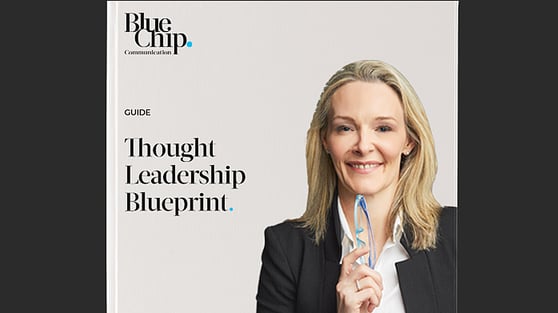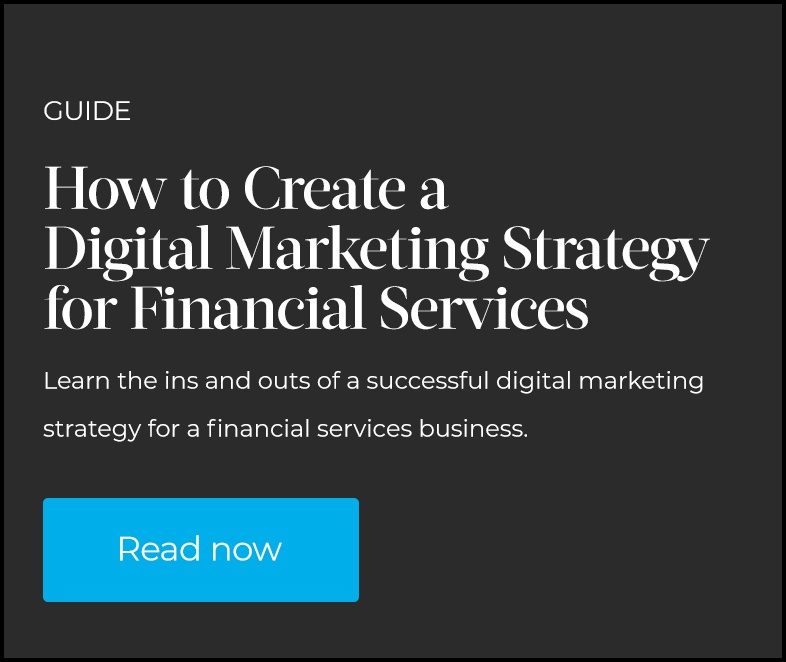If a blank screen fills you with dread, use our handy 15-step template to give your financial services blog posts punch, consistency and even a little SEO juice.
Blogs can be extremely useful financial services marketing tools. In offering genuinely helpful information, it helps your brand stand out from the crowd. This is good for the reader AND it’s good for you: driving prospects along the buyer journey to become customers and ultimately, even evangelists.
But with the internet awash with content, there’s no room for a ho-hum blog… well there probably is room but it’s on page 156 of the search engine results where no-one will ever read it. And like the philosophical question “If a tree falls in a forest and no one is around to hear it, does it make a sound?”, you have to ask yourself “If my blog appears beyond page 1 on Google and no-one reads it, does it really matter that I wrote it?”.
Existentialism aside, how do you get your ideal customer to read it? The answer is to produce content that’s worth reading. Of course you need to optimise it, distribute it, use your influencers’ reach to amplify it and a bunch of other activities, but we are going to focus here on helping you create a vast forest (perhaps even one that is visible from space!), one beautiful tree at a time.
Enter the ultimate financial services blog template.
This is your new best friend. It means you no longer need to start with that scary blank screen and it lets you focus on your message, all within a consistent framework.
Step 1: Identify your target audience and where they are in the Buyer Journey
Which of your buyer personas are you writing this blog post for and at what stage of the buyer journey are they? We cannot emphasise enough the importance of having your ideal reader in mind before you put finger to keyboard. Think about who they are, what they want to achieve or avoid and what information they need (and you want to provide) right now. Remember we discussed mapping your content to the buyer’s journey.
Step 2: Decide one thing you want your reader to know
If, after reading your blog, someone asked your persona what the article was about, what one message would you want them to relay back to you? This is your key takeaway. Every great blog needs a key takeaway because that’s what makes it worth your persona’s time to read it.
If you're writing for investors, here's specifically how to talk to investors in 2021.
Step 3: Create a short list of a few possible titles
The first title you choose probably won’t be the final title you publish. At least start with a working title that gives your blog post direction and unity. If nothing else, it’ll stop your writing rambling off course.
Once your post is written, revisit your list of possible titles to find the one that accurately reflects the blog post’s content, is intriguing enough to motivate your persona to want to read more and is optimised for search i.e. has your target keyword(s) in it.
Step 4: Use a framework to logically structure your post
The typical blog post consists of:
- An introduction: Describes the pain or aspiration your target reader is experiencing and promises them a solution
- A body: Steps them through the solution(s) providing information that teaches them something new or gives them a framework for thinking through the solution for themselves
- A conclusion: Summarises the post with a brief statement that wraps up what your readers just learned
Step 5: Frame the problem in your introduction
The introduction tells your persona that you understand their problem or desire and you are the right person to help them with it. The sole purpose of the introduction is to set stage for the “meat” of your post thereby motivating your persona to keep reading. Write a lousy introduction and you risk losing your persona’s interest as they click away to something more compelling (crazy cat video anyone?).
And just because your introduction appears first doesn’t mean you need to write it first. Often you’ll find it easier to write this section last.
Here’s a quick breakdown on a killer intro:
- Write a compelling opening sentence that introduces your personas problem or objective
- Explain the problem or objective in a little more detail
- Provide a transition that moves from the pain/need to an overview of the solution
Step 6: Provide the solution in your blog’s main body
This is where you deliver value to your persona. You need to follow through on your promise to provide a solution and ensure that you do so in an easy to understand way, which may be challenging in the financial services industry. Visuals are a great way to make complex information more digestible and lists can help you be concise. In fact, use whatever mix of paragraphs, bullet points, images, graphs etc you feel your persona will appreciate.
When your target audience does not consist of subject matter experts, another good way to explain complex concepts and make them interesting is to use relatable analogies. This helps to connect something completely unfamiliar to the individual and make it relevant.
Don’t worry too much about word count. Yes, your blog post should be more than 300 words from an SEO perspective (and really, how deeply can you cover a topic in less than that?) but rather than sticking to a minimum word count, stay focused on providing information that your persona needs and can action in some way.
Step 7: Put it into perspective in your conclusion
The conclusion is where you summarise what your persona has learnt. You can spell out for them how they’ve benefited from reading the blog and ask them a question that invites them to respond to you or challenges their own thinking. Are you up for the feedback? (See what I did there? No need to answer, I was just showing you what a concluding question could look like!)
Step 8: Hyperlink to other useful information
While you shouldn’t worry about word count, it isn’t practical or very reader-friendly to cover in detail everything you mention in your blog post. This is where hyperlinking to other resources can be helpful for those readers that want to dig further into a particular topic.
It also shows your persona that you’re across the topic. By referencing other content you demonstrate you’re widely read on the subject and therefore a subject matter expert.
Second, linking to other content on your website helps position your brand as source of information on related topics; perhaps even a first-stop for when your persona needs help. It also helps cross-promote your content, giving it a greater chance of being read more widely.
Finally, outbound hyperlinks i.e. links to websites beyond your own, help with your search engine rankings. While inbound links i.e. links from other websites to yours are most valuable, outbound links also provide cues to Google that you’re an authority on your subject and therefore worth bumping up the search results.
Step 9: Finalise your title
Now that the post is written, you can decide what title best describes its content. You’ll need to find a balance between descriptiveness, SEO-friendliness and Buzzfeed style click-bait. I like to use the free tool Emotional Value Marketing Headline Analyser or Coschedule’s Headline Analyzer to test some headlines for their likelihood of driving a human to click through on a blog post. It’s not a silver bullet but it does help choose words with greater impact to include in a title.
Step 10: Always include a Call-to-Action
Alec Baldwin’s character in the movie “Glengarry Glen Ross” taught his sales people ABC – Always Be Closing. While I’m not advocating the hard sell at the end of all your blog posts, I am encouraging you to think about what you want your persona to do next. It could be as “soft” as to read more of your content or interact with your brand via the comment box. At the other end of the spectrum and if the persona is closer to wanting to make a purchase decision, you could ask them to leave their contact details for one of your client services team to follow up. This comes back to Step 1 where you decided who you were writing for and where they were at.
Step 11: Edit
It’s very difficult to edit your own work. Ideally have someone in your team take the role of editor. A good editor will help the brand’s voice stay true without washing out the uniqueness of each author’s style.
A second pair of eyes will also help with simple hygiene issues like typos, grammatical errors and gaps in logic. It’s just part of good quality assurance.
Step 12: Get visual
As humans we are driven by visuals. Try to include at least one photo or image in every post, first so it’s more interesting for your reader but also so that when the blog post is published in social media channels, it includes a thumbnail image to entice a clickthrough.
There are plenty of royalty-free images to choose from if you don’t have a corporate image library already. In Google click on Images > More Tools > Usage Rights to filter for images that can be used commercially, otherwise other sites we recommend include Pixabay, Unsplash and Pexels. We also like stock image libraries like iStockPhoto and Shutterstock which have inexpensive options.
Step 13: Optimise your post for search
We asked at the beginning whether it’s even worth writing a blog if no one reads it so don’t run the risk of no one reading it! Search engine optimisation (SEO) is a giant, ever changing topic all to itself so we won’t tackle it here. What is worth mentioning is having a couple of keywords you’re targeting in mind when writing your blogs and including them as you write (or edit). If you’d like a blog template from an SEO perspective, then we are happy to share the one we developed for ourselves. Just email us and we'll send it to you.
Step 14: Publish and promote
Of course publish your post on your website (or wherever your blog lives) but don’t stop there. We are big fans of spending as much, if not more, time on promoting your content as you did on creating it. Think about all the places you can promote your blog post, including your social media channels, tapping influencers both online and offline, revisiting old content to update with links to the new content if appropriate, boosting with paid spend, inclusion in email signatures, encouraging staff to share with their networks and the list goes on. Develop a checklist of promotion activities you can run through every time you publish.
Step 15: Measure and improve
Make sure measuring and reporting the performance of your posts becomes part of your blogging rhythm. Visitor numbers are one metric to track but perhaps more interestingly you can track engagement, length of time on the page and clicks on the call to actions to get a sense of how interested your persona is in the topic.
This is great information for informing your content ideation and ensuring you are creating content your persona is interested in.
Download BlueChip's Thought Leadership Blueprint - a 7-step guide to help financial services experts articulate and communicate new perspectives effectively.













